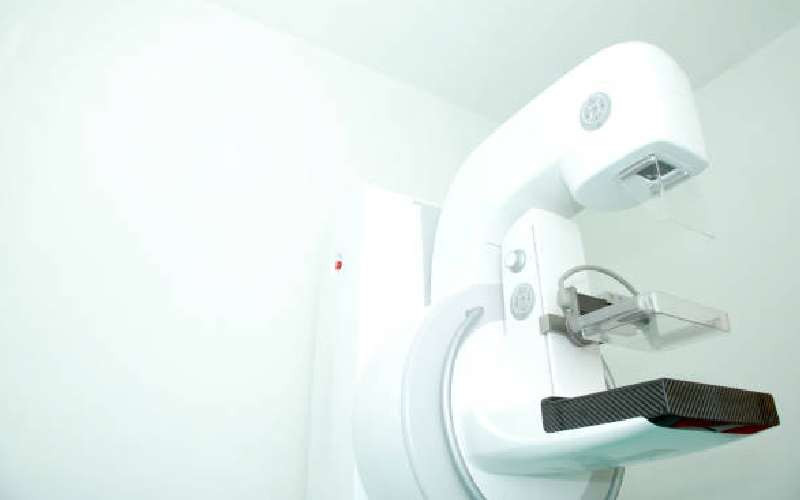
"I need you to go get this scan from the county referral hospital," I told her after the examination. "It is called a mammogram. We do not have one in this facility." It was the season. I had just seen a male patient with a rare type of breast cancer a week earlier. Diseases come in battalions; we say. For this male, I had had a long conversation about the CT scan with my colleague who has graciously co-authored this piece.
Breast cancer is the most commonly diagnosed cancer accounting for one in every eight cancers world-wide. Experts project that the number of new cases per year will increase by 40 per cent by 2040. Irrespective of cancer type or setting, it is important to note that the sole determinant of outcome is the stage at which a cancer patient presents. It is therefore important that as many as possible, if not all, cancers should be picked during their early stage to afford the patients a chance at cure. This is done through screening.
In breast cancer screening, mammography is one of the screening scans recommended for ladies over 40 years. It is an x ray target to the breasts to pick out any precancerous changes before they can be discerned by the hand or the eye. Since its invention over a century ago, adoption of mammography has been demonstrated to bring down cancer related mortality by over 30 per cent. Thus, various cancer treatment guidelines will advise mammography and breast examination as screening strategies for picking out breast cancer early.
The main use of mammography is early detection. Very small masses or clusters of micro calcifications (early warning changes). They wouldn't be seen on clinical examination by the doctor by ultrasound scan. Subtle changes in density are also suspicious on follow up mammography. They would otherwise be passed as normal. The use of mammography is however limited in the young dense breast and as such are not recommended for women under 40 years.
Our anecdotal observation locally is that mammography machines are not as widely purchased and installed in our health facilities as other scans.
'It will take you 22 years to break even with a mammography business in Kenya' according to projections by Africa Telerad. Africa Telerad is a teleradiology company which provides radiology reporting (for CT scan, MRI, Ultrasound, mammography, x ray) and image picture archiving and storage to over 100 hospitals across Africa.
This is quite a sizeable reach and the business projection, though making economic sense, does not portend good for cancer care in Kenya. Kenyans are clearly not heavy consumers of the mammography services. Whether because healthcare providers do not recommend, or population does not pick up is a discussion point. What is beyond doubt is that a quarter of all cancers in females in Kenya are breast cancer. Even when you lump males and females and count the cancers, breast cancer remains in pole position at 16 of every 100 people.
Though our observations still lack robust scientific data gathering, the enormity of the breast cancer burden makes one think that every available resource should be thrown at it. Granted, culture and health-seeking behaviour will heavily influence the uptake of whatever medical intervention is made available. But the cancer does not seem to respect cultural inclinations at all. Anecdotal observation by Africa Telerad in other countries, especially West African ones, points to a systemic push by the regulatory and insurance players to have these services consumed regularly. For example, there is a country with a police force that pays for female staff to have the mammography scans annually where indicated.
- Cancer patient's ordeal reveals cracks in healthcare system
- How a burst brain tumor changed DJ Muller's life forever
- Stage 4 cancer but still standing strong: Eunice Mwende's life after terminal diagnosis
- Cancer took my health, heartbreak everything else: Leah Wanjiru's silent battle
Keep Reading
Kenya does not have the culture of having mammography. Even the national referral hospitals could do with higher uptake of this service. The national government under the Managed Equipment service (MES) project installed several mammography machines at various county hospitals. The uptake has been low.
As the new government settles down and reorganises the National Health Insurance Fund as promised, perhaps capturing mammography among the benefits package across all cadres will bring the uptake up. There also has to be a sustained campaign to have breast education and mammography done all year round, and not just in October.
-Dr Stanley Aruyaru is a consultant general surgeon and author
-Dr Jocelyn Nyokabi is a consultant radiologist and co-founder, Africa Telerad
 The Standard Group Plc is a multi-media organization with investments in media
platforms spanning newspaper print
operations, television, radio broadcasting, digital and online services. The
Standard Group is recognized as a
leading multi-media house in Kenya with a key influence in matters of national
and international interest.
The Standard Group Plc is a multi-media organization with investments in media
platforms spanning newspaper print
operations, television, radio broadcasting, digital and online services. The
Standard Group is recognized as a
leading multi-media house in Kenya with a key influence in matters of national
and international interest.











